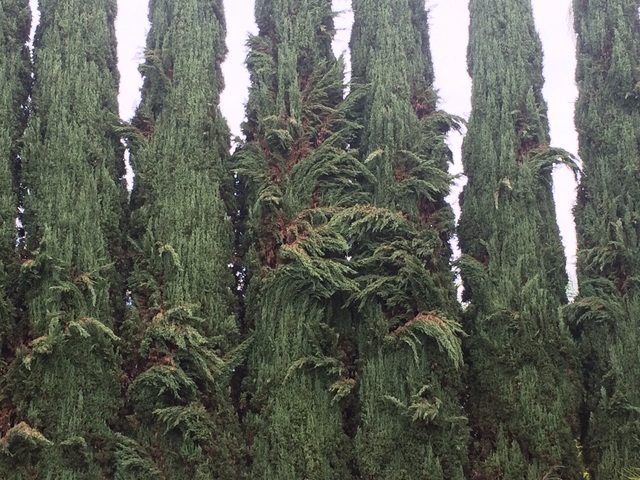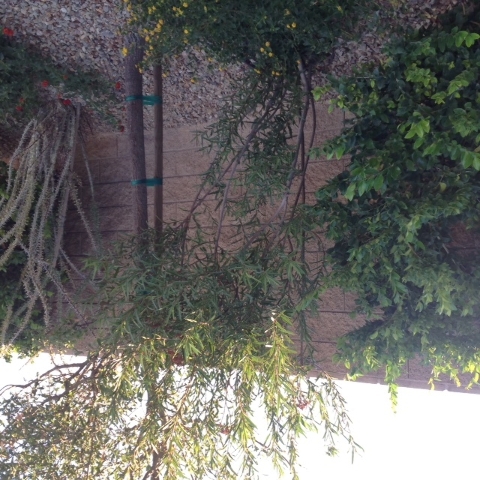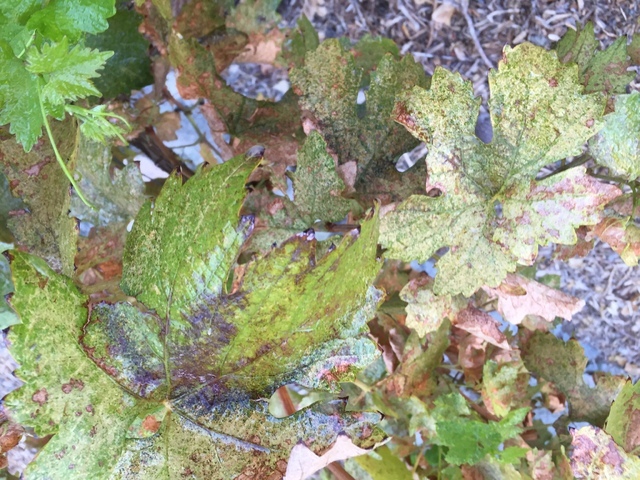Frequent watering can cause cypress limbs to droop
Q: Why are the lower limbs on my cypress tree drooping?
A: I think what you mean by cypress is Italian cypress. The other tree people might call cypress would be Arizona cypress, which is a totally different tree. Arizona cypress is used a lot in dry landscapes but is prone to borer problems, branch dieback and dead limbs.
Italian cypress branches can droop if the trees are watered too often. Watering frequently produces succulent growth that does not have the strength to remain upright.
Managing irrigations so that water is applied less often, or smaller amounts more often, should slow the growth and make new growth stiffer and less floppy.
Q: We have lived in the same house in Las Vegas for 42 years and every June my lawn has the same problem. The lawn is a mix of common and hybrid Bermuda grass. First, the grass turns grayish (in patches) and then brown. It slowly comes back by September. I water according to local recommendations, use Scott’s Turf Builder three to four times a year and use Ortho Bug-B-Gone insect granules twice a year.
A: If this were tall fescue I might be tempted to say this is a disease problem. However, since it is a mixture of Bermuda grasses, I think this is an irrigation problem. This will be particularly true if brown patches are in the same locations every year and don’t move around each year.
Bermuda grass in our climate doesn’t develop many insect or disease problems. This grayish color in lawns indicates drought. You may need to make some changes to your irrigation system.
The success of lawns in our desert climate is directly tied to the quality of an irrigation system. In technical terms, the irrigation system should provide “head to head coverage”; water from a sprinkler head should be thrown far enough to reach the head to its right and it’s left.
This should result in a more even application of water over the lawn. We call this irrigation uniformity. A lack of uniformity can result in brown patches because areas receiving less water don’t receive enough while other areas do.
The water pressure of the sprinkler system should fall within a range recommended by the sprinkler manufacturer. This is usually 45 to 60 psi. It can be measured by using a pressure gauge that screws onto a sprinkler head.
If the water pressure is too high or too low, it affects the distribution of water and creates browning in the same areas year after year. There are sprinklers now that lower the water pressure before this water is applied to the lawn.
Correct this problem in the short run by increasing the number of minutes you apply water during the hot summer months. This delivers more water to the dry areas. Unfortunately, it also delivers more water to the wet areas, resulting in overwatering of the green areas.
It is also a good idea to punch holes in the lawn with an aerating machine in the spring, particularly in the brown areas. This helps water to move into the soil and not run off into low spots if there are any.
Bermuda grass is notorious for building thatch. Thatch is a buildup of old grass stems and debris under the surface of the lawn but on top of the soil. Years ago, this thatch was burned off of the lawn with fire. We can’t do that anymore. We must do it mechanically now.
It is important to dethatch Bermuda grass each year. This is usually done in the fall when overseeding it with a cool season grass like rye grass to maintain a green winter lawn. If the lawn is not overseeded in the fall then thatch can be a huge problem in Bermuda grass.
Making changes to the irrigation system will correct some of this problem and reduce the amount of water needed to keep the lawn green. Increasing the number of minutes water is applied during the heat of the summer should solve this problem in the short run.
But combine this with lawn aerification every three or four years and dethatching every year to improve the amount of water entering the soil in the brown areas.
Q: We have an Arizona rosewood tree in our backyard. It is about 8 years old, is a double-trunk tree with 4-inch circumferences on each trunk. One water line waters it three times a day for a total of 30 minutes and is about 15 inches from the trunks.
We noticed that some of the leaves have been turning brown and falling from the tree. How many water lines should it have, what should their locations be and about how much water should the tree receive? What other problems may we be able to look for?
A: This is the wrong irrigation schedule for Arizona rosewood. This plant originates from the Sonoran Desert, so it is a true desert plant. This means it doesn’t like water applied frequently in small amounts as you are doing. It prefers water applied less often but in larger amounts of time.
Remember there are two components when watering: the amount of water applied and how often.
Right now, get the hose and slowly apply 20 or 30 gallons of water to the base of the tree. Keep this water in an area under the canopy about 4 feet in diameter and let it soak in really good.
Repeat this in one more week and you should see a difference in the tree during these two weeks. If you do, this tells you the tree is not getting enough applied water.
This tree prefers a large amount of water each time but not so often. A plant this size might require 20 to 30 gallons each time you water. During the winter you might get by watering every two weeks. In the summer, watering once a week with a large amount should be adequate.
With your watering schedule, it is probably not getting enough applied water but this small amount of water is applied too often. See if you can either change the irrigation timing to less often or put the tree on an irrigation valve that it applies water less often.
Increase the amount of water applied to the tree by adding more drip emitters. This is better than increasing the minutes. If you increase the minutes, then everything on that cycle gets more water, whether they need it or not.
There is a problem. This tree is now accustomed to frequent watering. Its roots have grown to favor your method of watering. The roots will be shallow, close to the surface and eagerly awaiting another irrigation.
At this age, this tree will have some difficulty adjusting to a totally new watering schedule. Make the changes in its irrigation slowly over time and supplement its need for water by using a hose.
One thing we can conclude for sure is it is a watering problem. I would get an inexpensive moisture meter for houseplants. Push it into the soil in several locations around the tree. Use this for deciding if the plant is getting enough water and scheduling your next irrigation.
Bob Morris is a horticulture expert living in Las Vegas and professor emeritus for the University of Nevada. Visit his blog at xtremehorticulture.blogspot.com. Send questions to Extremehort@aol.com.



















